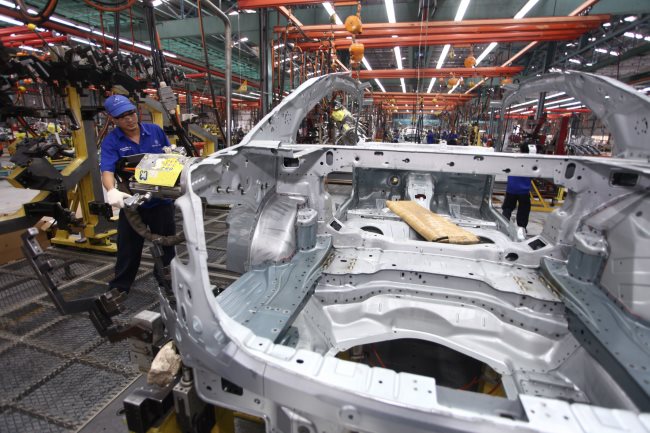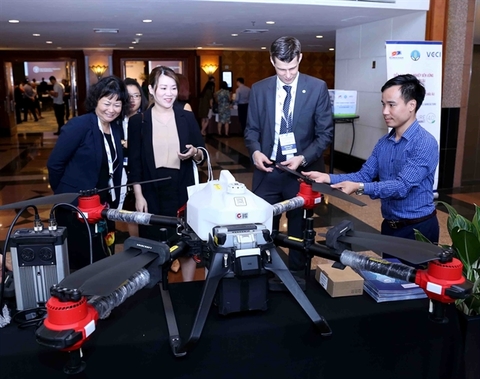Catapulting sustainable agriculture and growth
Catapulting sustainable agriculture and growth
The central region is cultivating suitable conditions for promoting high-tech agricultural development, an industry helping the region to court an influx of recent investment and laying the foundations for future sustainable development.
Most apparent are the preferential policies for investing in high-tech agriculture, and the government approval for establishing high-tech agriculture zones in diverse locations in the region, including Danang, Quang Nam, Quang Ngai, and Phu Yen.
According to Truong Quang Nghia, Secretary of Danang Party Committee, the development of high-tech agriculture helps formulate effective agricultural models and first-rate products, meeting the needs of urban people.
“Every year, the city benefits from quality supply of organic rice, high-tech clean vegetables on par with VietGap standards, and orchids. In the coming time, we will drive an emulation of model production and business farmers, in association with high-tech applications, focusing on quality and food hygiene and safety criteria,” Nghia said.
Localities have also been working on budget arrangements, transport infrastructure improvements, irrigation infrastructure, energy sources investment and more, making the region more lucrative to investors.
The growing appearance of new agricultural production brands has brought expectations of a fresh development stage for the central region’s agriculture.
Privately-held TH Group has initiated a project in the south-central coastal province of Phu Yen province, and FLC Group has also decided to invest in Phu Yen High-tech Agriculture Zone in Phu Hoa district.
Meanwhile, Binh Dinh province has a strong fisheries industry, and an economic sector which contributes greatly to agricultural development. In addition, as livestock is another advantage of Binh Dinh, the province has been successfully implementing a large-scale farm development model.
In particular, Binh Dinh has been deploying a cow-breeding programme, a high-quality beef cattle programme, and a safe vegetables enterprise with investment from New Zealand.
Quang Ngai province is no exception. Some major local players have set up headquarters in the province’s southern areas, such as Duc Pho and Mo Duc district. In addition to this, a Vinamilk project is being valued at VND700 billion ($30.4 million).
In the north, FLC Group has come up with a complex based in Dung Quat Economic Zone, including a component project on advanced agricultural development.
The authorities of Quang Nam province has a clear strategic vision for inclusive development in areas across the province, particularly in eastern and western areas.
In the east, expedient planning and strict management have helped to attract investment into industry, tourism, and high-tech agriculture with the participation of T&T Group, Dai Duong Xanh, Vingroup, Hoang Anh Gia Lai, and THACO, among others.
In the west, the beloved Ngoc Linh ginseng has been grown extensively in Tay Giang, Dong Giang, and Nong Son, creating a distinct ecotourism area. As for Danang, despite having a shrinking agricultural area, the city is now being positioned as a tourist spot.
Agricultural reform focus
High-quality holiday destinations are synonymous with good nutrition and food safety. In recent years, Danang has been keeping a close eye on controlling food sources, whilst simultaneously promoting modern agricultural production in Hoa Vang district to ensure that clean, safe, and high-quality food is supplied to visitors.
Phan Ngoc Tho, Chairman of Danang People’s Committee, said, “In the future, Danang will be focusing on agricultural development towards increasing added value and sustainability in association with building new rural areas. In this regard, establishing and developing clean and high-value agricultural production models in diverse ecological regions and expanding the application of high-tech agriculture models are our top priorities.”
The obvious effectiveness of modern agricultural methods has contributed to changing the mindset of local farmers, helping to formulate a new style of agriculture for rural workers throughout the region.
At the same time, the application of modern agricultural production models has enabled farmers to generate extra funding to reinvest in cultivation, livestock breeding, or processing, and made it possible to improve local transport and tourism infrastructure, bringing the countryside closer to the city.
Founder of TH Group, Thai Huong, stressed that nobody would lose their land. “Farmers will still cultivate their own area themselves. They have only leased it to the group, and become the group’s workers,” she said.
“We will provide farmers with technology and seeds, and then procure, process, and market the products to create a closed value chain in agricultural production, through planting, harvesting, and product processing and marketing, to benefit farmers,” Huong added.
Resonance
At the recent Central Region Economic Development Conference in Quy Nhon city of Binh Dinh, Prime Minister Nguyen Xuan Phuc emphasised the importance of the central region focusing on tourism development.
While the central area has been blessed with enormous natural resources, hence the phrase “golden forest, silver sea”, the region is unsure of how to avail of these resources in an effective manner, how to ensure sustainability, and how to maintain the forest ecosystem in the light of tourism development.
Ecotourism growth has thus far proved to be the right approach for the region, by forest development intertwining with farm models through the application of high technology, helping to protect forests and other valuable resources. This direction is taking shape in Danang, but it is still fragmented and has not been properly planned. In the eyes of industry experts, Danang has almost exploited its entire coastal resources and plain land fund.
Danang boasts many advantages in the Han River, mountains, waterfalls, and a diverse forest biosphere, which is why Sun Group and DHC Group are deploying an ecotourism model with Ba Na Hills, and Than Tai Mountain Hot Spring Park.
As for Thua Thien-Hue, the Truong Son mountain range is closer to the sea, while the majestic Bach Ma mountain and many other similar landmarks are calling for a new development vision, promoting their strengths while taking into account nature preservation for both local and international tourists.
In Quang Nam, many people enjoy the beauty of its two famous World Heritage sites such as Hoi An and My Son Sanctuary, but the province has much more to entertain visitors.
For example, sightseers can immerse themselves in the villages, where people fish and grow vegetables. What tourists need is a chance to experience this embodiment of Vietnamese culture, and the tranquility of the countryside.
Stretching from Nghe An to Binh Thuan, the central strip’s immense green space is calling out for mindful and capable investors to avail of local economic potential and help preserve the “golden heritage” for eternity.

















